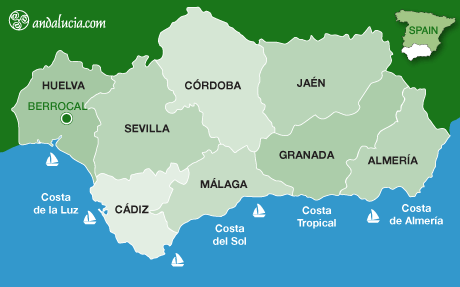Berrocal
by Saskia Mier
Berrocal is a charming village of approximately 400 inhabitants, located 305m above sea level in the eastern part of El Andévalo. The Rio Tinto river runs along the west side of Berrocal, between the mountains of Alabarderos, Sierra de Enmedio and Sierra de la Picota. Isolated by its own mountainous holm oak landscape still preserving the remains of prehistoric populations, Berrocal is a perfect place for those who want to enjoy a few days of tranquillity in touch with nature and history.
HISTORY
Although the origin of the population is not known exactly, it probably dates back to the Roman era, when the upstream mines of Rio Tinto were active and minerals were transported by road to the capital. Some remains of this Roman road are still visible in some sections connecting Escacena del Campo with the Rio Tinto mining sites. At the time it would have been a settlement that the Romans named Loelia, which was later named Berrocal.
Archaeological remains of the Chalcolithic period (also known as Copper age, an early part of the Bronze Age) such as dolmens from settlements can be visited.
THINGS TO SEE
Berrocal still remains very traditional with narrow and steep cobblestone streets.
Iglesia de San Juan Bautista
The 17th century Iglesia de San Juan Bautista (church),
Ermitas de Santa Cruz de Arriba
Ermitas de Santa Cruz de Arriba chapel can be visited (Calle Larga) to see the unique neogothic style architecture dating back to the 20th century.
Santa Cruz de Abajo
Santa Cruz de Abajo chapel can be visited (Plaza de Andalucia) and shows similar neogothic style architecture as Santa Cruz de Arriba, although stand out more due to its exquisite coloured exterior.
The oldest known monuments in the village are the stone walls surrounding the village dating back to the 14th century.
Hotels in Berrocal
Book Hotels in Berrocal
COUNTRYSIDE WALKS
The village is ideal for walkers to enjoy the wonderful natural surroundings, with many marked hiking routes, such as the River Hornueco, Charco de las Talliscas or La Ruta de los Friars. Before the forest fire that ravaged this part of Berrocal in 2004, the density and variety of trees was impressive (different species of oaks, some pines and eucalyptus). The current floras that can be seen are herbaceous species as well as autochthonous species such as oleanders, rockrose and some species of aromatics and brambles.
Despite the fire, many different species of animals can be found in the area. The stone walls are home to many reptiles and birds such as short-toed eagles, vultures, crows, jays, magpies, robins, wagtails etc. are also local to the area.
The most abundant wild mammals in this area are deer, wild boars and foxes. Also visible are otters, black storks and mongoose, although listed as endangered species.
The Picota hill is a viewing point from which to admire the beauty of the Rio Tinto river.
GASTRONOMY
The most popular dishes in Berrocal are stews and pastries; such as tortas de manteca (sweet butter pastries).
HANIDCRAFTS
Local crafts include products made of leather such as boots, bags and belts as well as pieces carved out of natural cork and local honey, although this is not sold outside the village.
FESTIVALS
Cruces de Mayo celebrated the first weekend of May dating back to the 15th century. An existing rivalry between Cruz de Arriba y Cruz de Abajo, it is a celebration of pagan and catholic rites.
San Juan is held the last weekend before the 23rd June to celebrate San Juan Bautista the patron saint of Berrocal. It is tradition that the night before, a log of eucalyptus is decorated with flowers and placed in the village square.
San Lorenzo celebrated at the end of the summer harvest. The festival lasts 5 days and consists of theatre productions, concerts and dances in the village fairground.
Virgen del Rosario is the patroness of Berrocal and celebrated 6 October. A religious festival of mainly church services held throughout the day.
Semana Santa (Holy Week) is a very religious festival consisting of daily processions and church services.
Corpus Christi celebrated by decorating the streets and entrances of churches with palm leaves ready for the procession.
Sachos is a tradition in Berrocal mainly celebrated between grandparents and grandchildren. Long pieces of wood are collected and all competitors stand round a central bonfire, the last one to burn out is the winner.
LOCATION
Berrocal is about 75km from to the capital of Huelva; to get there, take the Autopista del Quinto Centenario (A-49) until the km 49, then exit onto the A-493 towards La Palma del Condado. After passing through the town of La Palma del Condado, take the HU-4903 until you reach Berrocal.
